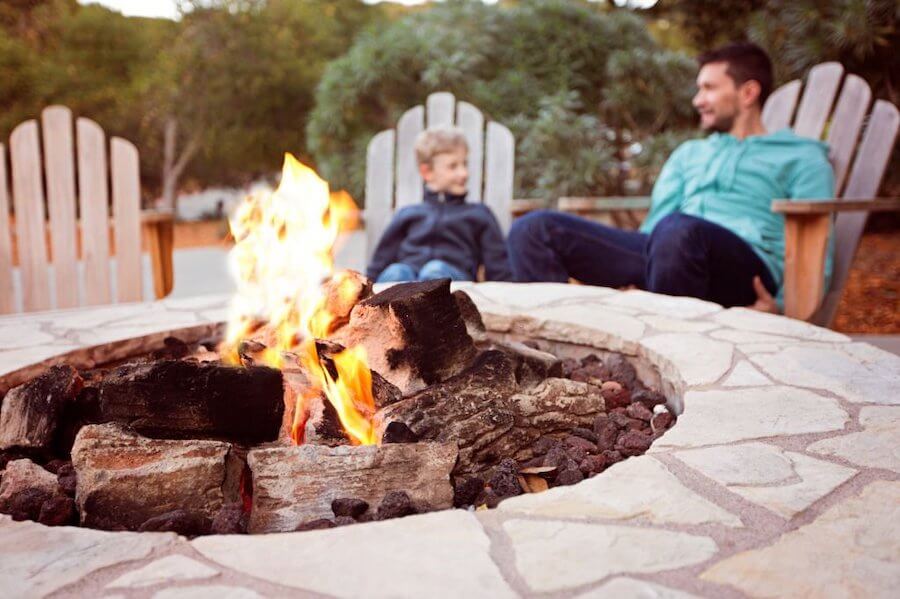The use of fire pits has become popular recently. More people are using them to create a warm, inviting atmosphere outdoors on their patio or in their yard.
Some owners prefer to use their fire pits under their covered patios but do not know how to use them safely. That is why we are here.
So can you use a fire pit under a covered patio? Let’s get into the details!
Table of Contents
Can You Use A Fire Pit Under A Covered Patio?
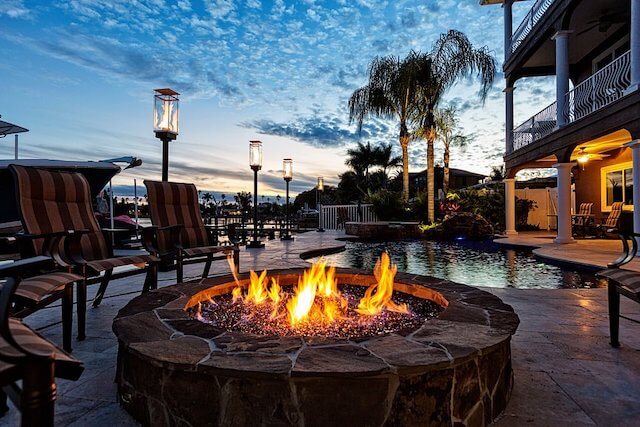
The short answer is yes! It is possible to use one fire pit under your covered patio. But you must take a few precautions to ensure safety.
Ceiling Height
Start by finding out if the ceiling on the covered patio is high enough to allow you to put a firepit underneath.
The heat from your pit should go straight up, which can cause severe damage to your ceiling over time. In the worst case, it can cause a fire if it is too close.
So you’ll want to check out the recommended minimum height of the manufacturer and the city’s regulations and codes to ensure you can place one fire pit under your covered patio.
Location
This step involves checking out the manufacturer instructions and your city to determine the minimum distance required for your fire pit location.
Make sure your area is open, clear, and free of plants, low-hanging trees, or other things that can easily catch fire.
Ventilation
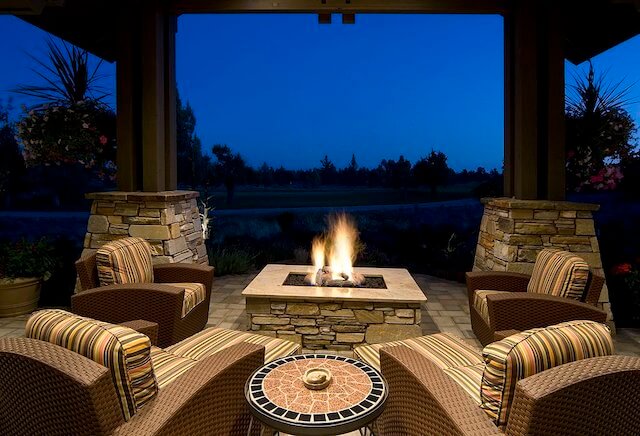
Always avoid using your fire pit in one enclosed space. Smoke is considered highly toxic and can build up quickly if a fire does not get proper ventilation.
You should check out the city and manufacturer requirements to determine how much of a structure should be open to enable proper airflow.
Flooring
You also need to consider the kind of flooring available on your patio.
Composite, vinyl, and wooden flooring are some of the combustible surfaces. So you must take care when using your fire pit on top of them.
Besides, concrete, stone, and brick flooring are some of the safest options.
Kind of Fire Pit
Gas Fire Pit
You should install a gas fire pit under your covered patio, but you need to confirm it is pre-approved by your city first.
It is essential to ensure that the outdoor space’s ventilation, location, ceiling height, and flooring meet the manufacturer’s requirements before installation.
We recommend keeping a fire extinguisher nearby for the burning experience.
Wood-Burning Fire Pit
You should not use this fire pit type under your covered patio. Wood will produce toxic and thick smoke.
If there isn’t enough airflow, this smoke may build up quickly, leading to depleting the space of oxygen.
Furthermore, wood fires create embers and sparks, which might fly around and ignite combustible materials nearby.
We recommend using wood-burning fire pits in open areas with good ventilation and staying far from combustible materials.
Safest Options for The Covered Patio
Two of the safest choices for warmth and ambiance to your covered patio are an outdoor fireplace or patio heaters.
Whichever option you pursue, you will be overwhelmed by various fuel types, styles, and shapes.
The key is to choose one that works best for your individual needs. Also, you must ensure yours are approved for usage in the outdoor space.
Outdoor Gas Fireplaces
An outdoor gas fireplace is also an excellent choice for those who prefer to add warmth and ambiance to their outdoor space.
It can be much more efficient than the wood-burning style and generate more radiant heat.
The gas fireplace is available in Ventless style, which does not require one chimney system, and you can install it on the combustible walls. It means installing it almost anywhere is possible.
Outdoor Masonry Fireplaces
Traditional outdoor masonry fireplaces can deliver the rustic experience many individuals covet from wood-burning fire pits.
It is feasible to install one of the factory-built wood-burning fireplaces or make one custom fireplace.
These fireplaces still generate smoke. So you will need to prepare a chimney approved by the manufacturer for proper ventilation.
Also, you must carefully watch and extinguish the fire before you head inside.
Patio Heaters
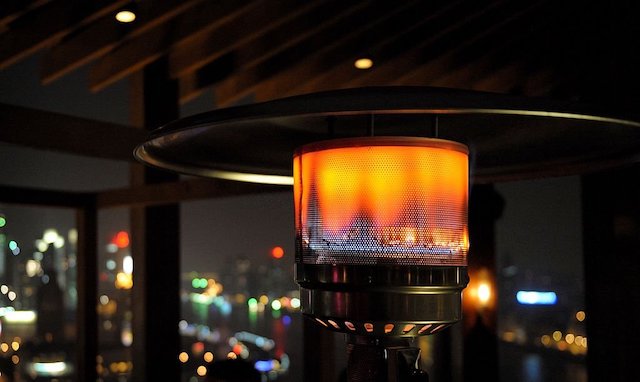
If adding heat to the outdoor space is your top priority, a patio heater will be the one to get. It comes in various sizes and is fueled by electricity or gas.
You can mount an electric patio heater on the wall or install it on the structure’s ceiling to create constant warmth when you lounge below.
It is entirely safe for use in an enclosed space, and you can even use it indoors.
The gas patio heater is still one of the combustion appliances. So it still requires reasonable ventilation and clearance to combustibles.
FAQs
Can I Put My Fire Pit Under Pergola?
It’s possible. You and your friends and family can safely enjoy the wonderful ambiance of your fire pit underneath your pergola with thoughtful placement, proper ventilation, and safety practices.
Many believe they cannot put their fire pit underneath a pergola as it is dangerous, but this is a myth.
How Much Overhead Clearance Do I Need for a Fire Pit?
21 feet is the required distance. However, it is best to refer to the manufacturer’s recommendations for the accurate answer.
Are Fire Pits Safe on a Patio Deck?
The answer is Yes. However, you must ensure your fire pit is protected with non-combustible material such as concrete, bricks, or one fire pad.
Fire pit pads, or fire pit heat shields, are considered ideal insulative materials for use under fire pits on a wooden deck, grass, or any other surface and can withstand up to 1400 degrees.
Can I Place A Gas Fire Pit Under A Patio Roof?
Always put your firepit on a non-combustible, steady, solid surface like a brick or stone patio. Never situate it on or near a wood.
Whatever fire pit you own, avoid placing it under low-hanging tree branches or a covered porch.
Can I Put My Fire Table In A Screened Porch?
Natural gas and propane fire tables are made for only using outdoors. So you won’t be able to use them indoors and in confined spaces.
You can use these fire tables on a screened-in porch or open-air if you follow the manufacturer’s guidelines for ceiling height clearances and wall clearances.
What Should I Put at the Bottom of My Fire Pit?
Several materials, such as gravel, sand, or hard rock, cannot reach high temperatures and might spark or explode if the fire gets too hot.
You should use lava glass beads or lava rocks, which serve as a filler for a fire pit. They’re one of the safe ways to create drainage and make fire pits look nice.
Is It Okay to Put My Fire Pit on Grass
The answer is No. It is unwise to operate your fire pit on grass. You don’t like to be responsible for starting a wildfire, do you?
You need to follow standard fire safety if you are considering using a natural gas or propane fire pit on grass protocols.
Can I Cook On A Gas Fire Table?
We recommend not to cook food on your gas fire table due to soot and carbon.
But if you’re in a pinch and want to cook over one gas fire pit, you should use a large griddle or flat cast iron pan to keep your food out of direct contact with the gas flames.
What Fuel Can You Use in a Fire Pit?
If you’re looking for the best fuel for a fire pit, you can choose one of these eight options below:
- Firewood
- Wood Briquettes
- Charcoal
- Propane
- Gel Fuel
- Natural Gas
- Smokeless Fuel
- Ethanol and Bioethanol
How Many Types of Fire Pits?
There are four types of fire pits, including:
- Wood Burning Fire Pit
- Propane Fire Pit
- Gel Fuel Fire Pit
- Natural Gas Fire Pit
Which Is the Best Fire Pit for Cooking?
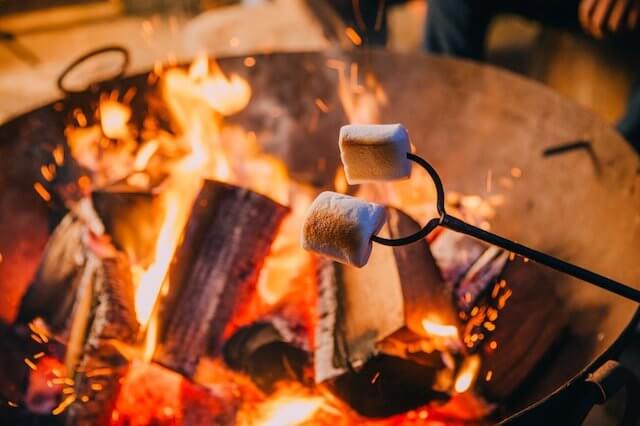
The wood-burning fire pit is the most popular type and is also ideal for cooking.
Before starting your cooking sessions, pick firewood carefully. We recommend refraining from using softwoods, such as pine, as they create a resinous smoke that might spoil your food flavor.
Wrapping It Up
Can you put your fire pit under the covered patio? Yes, you can, but you must take some precautions for safety reasons.
Never use fire pits in an enclosed space. If it does not receive ventilation, your fire pit might cause a buildup of harmful gasses and toxic smoke.
So the key is to use your fire pit in one open space, allowing it access to plenty of airflows. Always follow the manufacturer’s instructions and recommendations.

